Special Surface Treatments for Touch Screen Glass Covers
The current mainstream processes for cover glass surface treatments include AG (Anti-Glare), AR (Anti-Reflection), AF (Anti-Fingerprint), AM (Anti-Microbial), and AUV (Anti-UV).
In this issue, we will delve into the key technologies of the four major surface treatment processes for cover glass: AG (Anti-Glare), AR (Anti-Reflection), AF (Anti-Fingerprint), AM (Anti-Microbial), and AUV (Anti-UV). Each of these technologies has unique applications and advantages, which are crucial for enhancing the performance of cover glass. By understanding the core differences among these technologies, we can better select the appropriate surface treatment solution for specific needs.
Cover glass, as the outer protective material of touch screens, is commonly referred to as Cover Lens or Cover Glass in the industry. The materials are mainly divided into soda-lime glass and high-alumina glass. Glass covers crafted through special processes not only possess characteristics such as impact resistance, scratch resistance, and oil resistance but also excel in fingerprint resistance and enhanced light transmittance. However, the quality of the glass cover that directly contacts the external environment is not determined solely by parameters such as surface smoothness or thickness. Key attributes such as high hardness, pressure resistance, scratch resistance, and anti-microbial properties collectively form the foundation of cover quality.
The following sections will introduce the mainstream processes of AG, AR, AF, AM, and AUV special surface treatments.
1. AG Glass (Anti-Glare Glass)
Through chemical etching or spraying technology, the originally smooth glass surface is transformed from a mirror-like reflection to a diffuse surface, creating a matte effect. This treatment allows external light to form diffuse reflections, effectively reducing glare and providing a more comfortable visual experience. AG glass is widely used in outdoor and brightly lit display scenarios, such as vehicle displays, vending machines, fuel dispensers, advertising screens, ATMs, POS terminals, and medical displays. Depending on the usage environment and budget, indoor glass can opt for a sprayed anti-glare coating, while outdoor glass is recommended to undergo chemical etching treatment to ensure the durability of the AG effect.
The image below compares ordinary glass and AG glass.
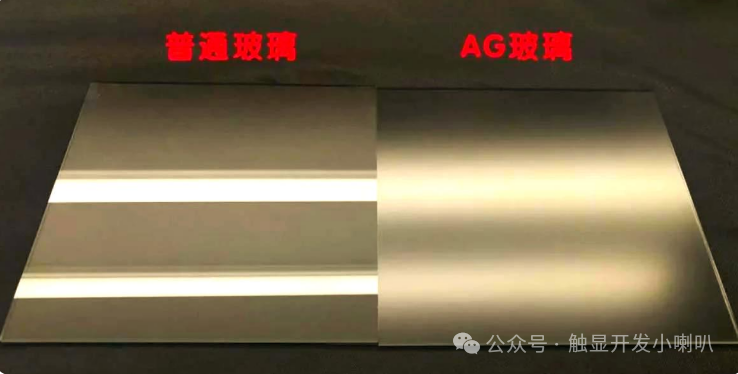
Key Parameters:
Gloss: 60~150 (WGG-60 gloss meter test)
Surface Roughness (Ra): 0.2~1.5μm
Haze: 10%~30% (adjustable based on requirements)
Light Transmittance Loss: <5% (compared to original glass, in the 380–700nm visible light wavelength range)
Clarity: Clarity is related to particle span; the smaller the particles, the higher the clarity.
Glare Points: Glare points are proportional to gloss; the lower the gloss, the fewer the glare points. Increasing roughness can reduce glare points, but glare points may also be affected by other factors.
To determine if the surface has undergone AG treatment, when light is transmitted, the naked eye can perceive a hazy feeling.
2. AR Glass (Anti-Reflection Glass)
Using vacuum coating technology (magnetron sputtering or evaporation), multiple layers of optical films (such as SiO₂, TiO₂) are deposited to reduce light reflection. This significantly lowers the reflectivity while greatly increasing the light transmittance. Its transmittance can be improved to over 99%, while the reflectivity is reduced to below 1%, ensuring the clarity of the displayed content and providing viewers with a more comfortable and clear visual experience. AR glass is widely used in glass greenhouses, high-definition displays, picture frames, mobile phone and camera lenses, as well as in the solar photovoltaic industry. To identify AR glass, simply compare it with ordinary glass in front of a display.
Ordinary glass on the left, AR glass on the right.
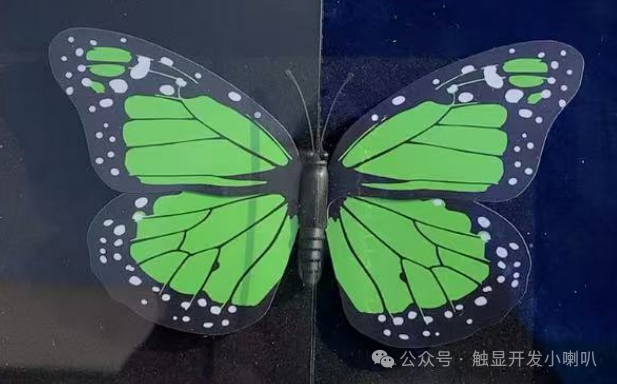
Key Parameters:
Film Thickness: Single layer λ/4 (approximately 100~150nm), total thickness of multilayer films 300~600nm.
Reflectivity: <1% (in the visible light spectrum).
Adhesion: Tested by crosshatch test (ASTM D3359).
Wear Resistance: Taber test (500 cycles, CS-10 wheel, weight loss <0.5%).
Can be coated on one side or both sides.
3. AF Glass (Anti-Fingerprint Glass)AF glass has a surface treated by vacuum evaporation coating technology, applying a layer of nano-chemical material that mimics the lotus leaf principle, reducing the surface tension of the glass to a minimum, decreasing the contact area of dust with the glass surface by 90%, endowing it with excellent hydrophobic, oil-resistant, and anti-fingerprint properties. Generally, SiO2 + AF materials (DON, M4, Dow Corning AF materials) are used. This glass is easy to clean; whether dirt, fingerprints, or oil stains, they can be easily wiped away, keeping the surface smooth and mirror-like, and providing a more comfortable touch. It is widely used in the display glass covers of various touch screens, especially single-sided AF coating technology, which gives the glass front excellent anti-fingerprint effects. To identify this type of glass, simply drop a drop of water or draw a line with an oily pen; the AF surface will show water droplets that can roll freely, while the non-AF surface will show a water puddle that cannot be drawn with an oily pen.
The image on the left shows glass with AF, and the right shows glass without AF.
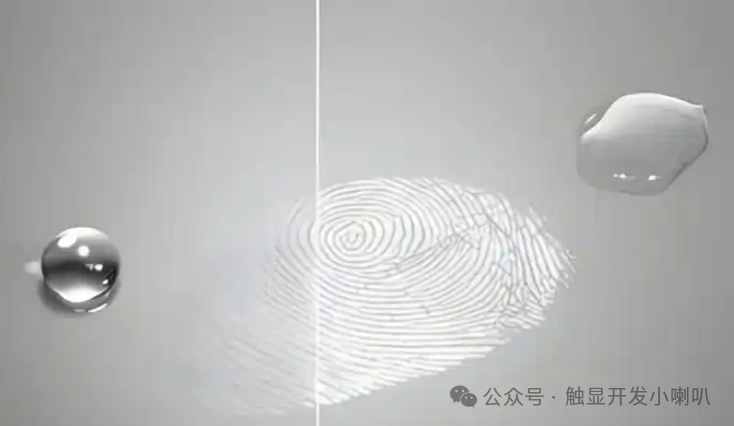 Key Parameters:
Key Parameters:
Water Contact Angle: ≥110°
Coating Thickness: 10~50nm.
Wear Resistance: After 500 cycles of steel wool friction, the contact angle remains >90°.
Curing Conditions: 120℃~150℃, 30~60 minutes.
4. AM Glass (Anti-Microbial, also known as Antibacterial Glass)
Anti-microbial glass performs exceptionally well in both household and medical fields. For example, in households, it is used to manufacture tableware and sinks, effectively preventing the spread of bacteria; in medical facilities, anti-microbial glass is used for partitions in operating rooms and wards to reduce the risk of cross-infection.
There is a dedicated article on this topic titled “Principles of Antibacterial Glass and Reliability Testing Standards”; interested readers can check it out.
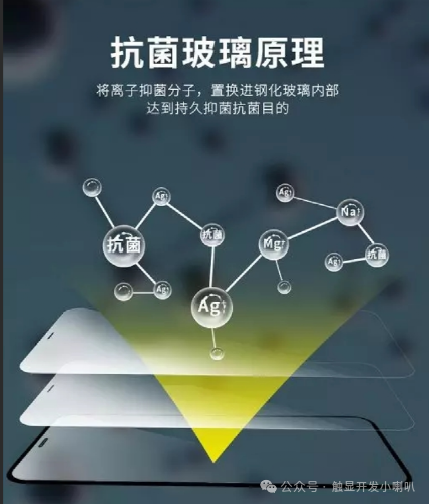
Key Performance Testing Standards:
1.Antibacterial Rate:
Testing Standards: ISO 22196 (bacteria), ISO 846 (fungi).
Requirements: Antibacterial rate ≥99% against common strains (such as E. coli, Staphylococcus aureus).
2.Durability:
Wear resistance test (Taber test, antibacterial rate >90% after 1000 cycles).
Weather resistance (QUV aging, performance retention rate >80% after 500 hours).
3.Safety:
Metal ion leaching (e.g., Ag⁺ < 0.1ppm, compliant with FDA or EU 10/2011).
5. AUV Glass (Anti-UV Glass)
Anti-UV glass primarily resists ultraviolet rays (wavelength 280-400nm) that can damage screen components, extending the lifespan of the screen and maintaining the clarity and color stability of the screen. Using magnetron sputtering coating technology, plasma bombards target materials (such as TiO₂, SiO₂), causing target atoms to deposit on the glass surface to form a nanoscale film.
Compared to ordinary glass, it has a blue or blue-purple reflection, with color differences between batches, and the current process cannot control this (for those with color consistency OCD, choose carefully, haha).
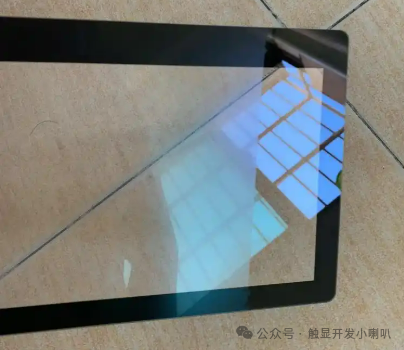
Key Parameters::
Target Material Ratio: Alternating coating of TiO₂ (high refractive index) and SiO₂ (low refractive index) to form multilayer interference films, typically 5-15 layers.
Thickness Control: Single layer film thickness 10-50nm, total thickness 0.1-1μm.
UV Blocking Rate: >95% (wavelength 315-400nm), visible light transmittance >92%.
Advantages: High precision, strong adhesion, suitable for complex curves (such as 3D glass).
Selection Recommendations:
1. AG: Gloss 110: automotive industry;
Gloss 95: suitable for indoor bright environments, such as medical equipment, projectors, etc.
Gloss below 70: suitable for outdoor environments, such as advertising machines, etc.
2. AR: Double-sided coating performance is superior to single-sided coating, the difference lies in cost, with slight color differences compared to ordinary glass surfaces.
3. AF: There are both evaporation coating and spraying processes, with the former outperforming the latter in all aspects; the latter’s advantage is lower cost.
4. AM:Excessive metal ion concentration can cause glass to yellow (e.g., Ag⁺) or turn green (Cu²⁺).
5. Consumer Electronics: Magnetron sputtering multilayer oxide films (balancing cost and performance).
Outdoor Equipment: Sol-gel method + nano-ZnO to enhance weather resistance.
Medical Displays: Organic-inorganic hybrid coatings to avoid CeO₂ biotoxicity.
6. The aforementioned four special surface treatments can exist individually or in multiple combinations, but not in arbitrary combinations.
Those interested in this topic are welcome to discuss.